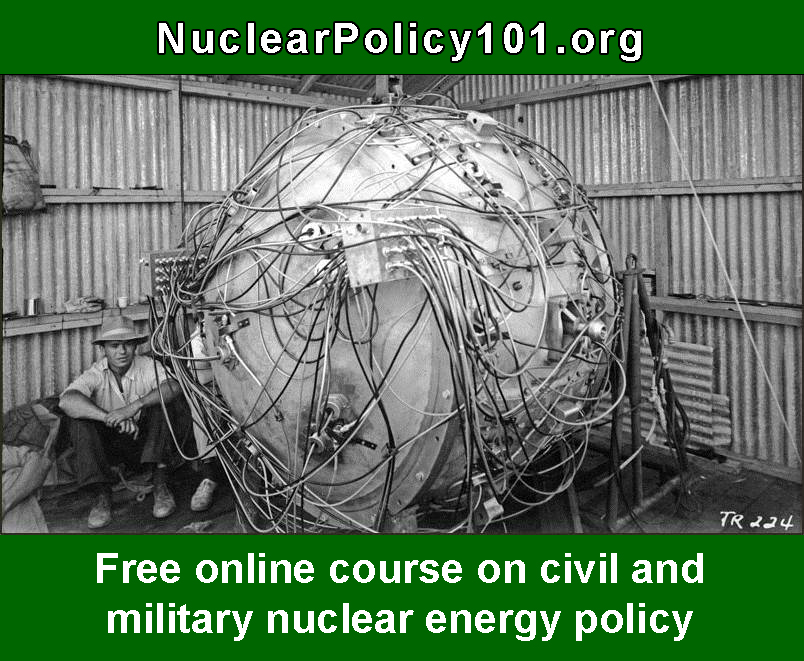During the early 1970s the US nuclear industry was keen to promote reprocessing, through which plutonium is separated from spent nuclear reactor fuel and then fabricated into new fuel — either plutonium fuel or mixed plutonium oxide/uranium oxide (MOX) fuel. Although such reprocessing initiatives enjoyed support at the time from some in the US government, Albert and Roberta Wohlstetter, Henry Rowen and other strategists voiced skepticism as they called attention to the proliferation risks raised by the spread of nuclear fuel-making activities, and especially plutonium-related activities.
 |
In late 1975, little more than a year after India had detonated a nuclear explosive device built with US- and Canadian-origin nuclear materials and technologies procured through civil trade, the Wohlstetters, et al., completed Moving Toward Life in a Nuclear Armed Crowd?, a nearly 400-page study on the military potential of civilian nuclear energy for the US Arms Control and Disarmament Agency (ACDA). (This 1975 ACDA report was later published by the University of Chicago Press as Swords from Plowshares: The Military Potential of Civilian Nuclear Energy in 1979. Swords from Plowshares, I hasten to add, should be required reading for anyone interested in nuclear energy and proliferation issues.) The policy impact of this report was considerable.
In the months following the Wohlstetters and Rowen — as well as ACDA director Fred Iklé, Nuclear Regulatory Commissioner Victor Gilinsky and many others — testified before Congress, and raised the Legislative Branch’s awareness of the security, economic and political issues surrounding activities related to plutonium fuel-making and exports. In turn, some members of Congress began to exert pressure on the Executive Branch to reassess America’s nuclear policy, especially with respect to plutonium and reprocessing.
In the summer of 1976, the Ford Administration assembled an interagency panel — led by Robert Fri, at the time the deputy administrator of the Energy Research and Development Agency (ERDA), and composed of representatives from ACDA, the Office of Budget and Management (OBM), and the Department of State — to examine US nuclear energy and export policy. The panel’s still-classified study, known as the “Fri Study,” reportedly offered both a majority and minority view on what changes should be made to US energy and export policy.
Soon thereafter the White House announced some rather dramatic policy changes. On October 28, 1976, President Gerald Ford decided that the United States would defer the pursuit of activities to reprocess spent-fuel and separate plutonium, to fabricate plutonium- or MOX-based nuclear fuels, and to export such fuels.
Then, on April 7, 1977, President Jimmy Carter, who had made nuclear nonproliferation a central issue during the 1976 presidential campaign, went further, deciding to make this American deferral indefinite.
It is interesting to recall how Atomic Industrial Forum president Dr. Carl Walske — who, in his capacity as the US nuclear industry’s chief spokesman, had vehemently opposed such revisions to US nuclear policy — begrudgingly called Wohlstetter and company’s 1975 ACDA report “the most significant single event” in “the current call for change” in a 1977 speech. (For anyone interested, I have electronic copies of Walske’s speech.)
Epilogue. On July 16, 1981, President Ronald Reagan effectively ended the deferral. By that point, though, the US nuclear industry had apparently found spent-fuel reprocessing to be far too uneconomical to pursue without government subsidies, and so the market had the effect of forcing the US nuclear industry itself to defer. But on September 27, 1993, President Bill Clinton decided to resume America’s deferral of spent-fuel reprocessing, plutonium and MOX fuel-making and plutonium-related exports. The deferral has remained policy ever since.
Things may be changing, however. Current Department of Energy (DoE) initiatives — in particular, the speculative Global Nuclear Energy Partnership (GNEP) — aim to reverse the longstanding US deferral of spent-fuel reprocessing and commerce in plutonium fuels, and promote worldwide what the DOE hopes will be new generation of allegedly “proliferation resistant” plutonium fuels and reactors. Although the goals of GNEP will not likely be realized for decades (if ever), some in the DoE are already talking as though truly “proliferation resistant” plutonium fuels and reactors are all but reality. They do this largely through a rhetorical slight of hand, however. For whereas the DoE once measured “proliferation resistance” based on how difficult it would be for State actor to divert nuclear material for military purposes, it now wishes to measure “proliferation resistance” based on how difficult it would be for a non-State actor to divert such material.
As the US contemplates what it should — and should not — be doing to promote civil nuclear energy domestically and internationally, the writings of the Wohlstetters on the military potential of civil nuclear energy remain relevant. In the coming days and weeks, this website aims to bring to light many of these previously unpublished, but still timely writings.





